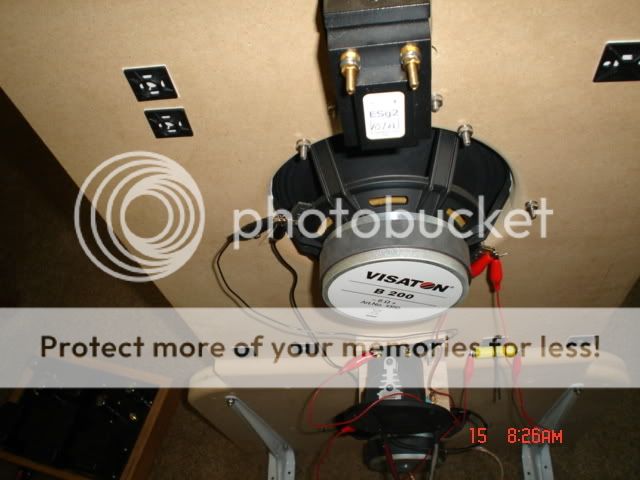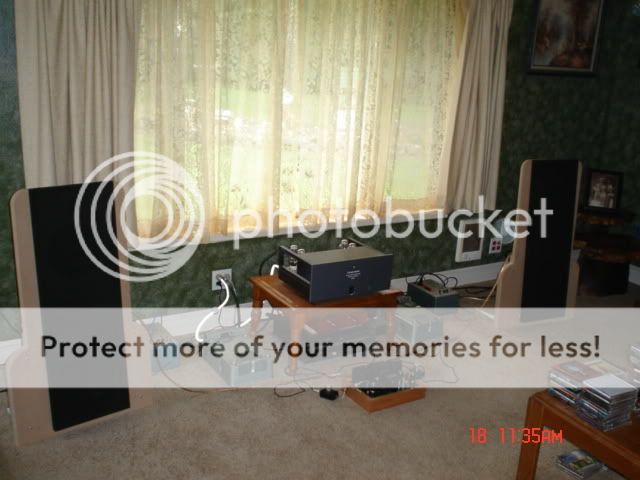johninCR said:I'm pretty sure the SI's have a different cone than the Beta15.
From what I've read, I'd agree.
Baffle size and shape will certainly make a difference. And getting some low end support will change how the mids sound. Don't freak out until you've tried a few more options.
That said, I do think that a Qts of around 0.6 gives a nice balance. Let us know what the result of the parallel resistor is.
Since you are fully active, your choices are almost limitless. I would try cutting the bass off the Iris @ 150hz & bring in the bass augmentaion @ active 4th @ least.. the mids should clear up big time..I am also no fan of wings of any kind around the fullranger..Imaging suffers & mud IMO. also 18" is a good # for baffle width..If you scrap the Iris try any fullranger of choice & try a rear fire tweeter only between the fullranger & bass driver.@ 10k or so. I started playing with rear fire ribbon between B200 & Bass augmentation driver on same baffle@ 10k. I also run a line level correction circuit now on B200 w/ a PLLXO HP 150hz of 6db beforet he correction circuit. You bieng fully active I can amagine doing even better.




JandG,
I assure you that your experience with wings is incomplete. They are just harder to get right because except for woofer frequencies it is essential to address edge diffraction. Bigger baffles partially address it because pressures are lower. My best imaging baffles remain my little 108 baffles with wings.
I assure you that your experience with wings is incomplete. They are just harder to get right because except for woofer frequencies it is essential to address edge diffraction. Bigger baffles partially address it because pressures are lower. My best imaging baffles remain my little 108 baffles with wings.
An externally hosted image should be here but it was not working when we last tested it.
I believe you. Your testing is extensive to say the least. I just get frustrated with wings around fullrangers, I see you have no sharp edges on any of your wings I have seen..so that is the importance of edge defraction, I do simple roundovers, but I see you have nice smooth trans istions on your winds, even your B200 set up.. I am to experiement with wings in the ower portion of my baffle with ripped concrete for tubes cut into 90* 1/4,, but onl @ lower portion, then just blue tape them on for the experiment. When I did the cut 90* form tube around the B200, bass became nice, but magic suffered also..Many more experiements to do..I you getting attacked for info on your wave guides yet..?
JandG,
I've just been after the smallest forms possible since I started with OB's, and that was even before I realized that you get more bass per inch of baffle material. Now recently on top of that, I realized in the bass section you also can get a little extra free ride with U's on top of that (like the free effective port length on a BR).
I've just been after the smallest forms possible since I started with OB's, and that was even before I realized that you get more bass per inch of baffle material. Now recently on top of that, I realized in the bass section you also can get a little extra free ride with U's on top of that (like the free effective port length on a BR).
OK, I tried parallel resistance. Absolutely no change. I tried values of 20R, 10R, and 5R. When I say nothing changed I mean NOTHING. Not even SPL level.
The strange thing is when I tried the opposite, series resistance, it got noticeably "boomy-er", albeit at a lower SPL.
At least I know the series resistance trick works for a higher Qts, I'm not so convinced about the parallel resistance. I would like to see some proof that parallel resistance is supposed to work.
The strange thing is when I tried the opposite, series resistance, it got noticeably "boomy-er", albeit at a lower SPL.
At least I know the series resistance trick works for a higher Qts, I'm not so convinced about the parallel resistance. I would like to see some proof that parallel resistance is supposed to work.

I also wanted to ask if anyone has heard the Selenium D210Ti compression driver?
I want to replace the stock Eminence ASD1001S that came with the SI's. The problem with the ASD1001S is that when I try to XO at or below 2.5k the thing starts to get really "shouty".
Before I buy a new driver though, is there any possibility that the small horn of the SI 15" is causing this? I would hate to buy a new compression driver just to find out this is the case.
I want to replace the stock Eminence ASD1001S that came with the SI's. The problem with the ASD1001S is that when I try to XO at or below 2.5k the thing starts to get really "shouty".
Before I buy a new driver though, is there any possibility that the small horn of the SI 15" is causing this? I would hate to buy a new compression driver just to find out this is the case.
theAnonymous1 said:I also wanted to ask if anyone has heard the Selenium D210Ti compression driver?
Yeah, I have a pair. Pretty good driver. It's got a couple of resonances to deal with down low, but nothing out of the ordinary for a 1" compression driver.
tinitus said:Shouty mids .... how do you make your xo
24dB/oct active bi-amped. I've used this setup with other speakers and it's definitely not the problem. The compression driver is the problem. It actually starts to sound bad under 3k, but really kicks in at 2.5k and under.
I'm starting to think this setup isn't for me. Maybe I should just start the NSB ob line arrays I've been putting off for nearly 3 years now. I tried a test baffle with 8 NSB's and 12 tweeters and the thing kicked like a mule. No "boomyness" whatsoever.
I want to replace the stock Eminence ASD1001S that came with the SI's. The problem with the ASD1001S is that when I try to XO at or below 2.5k the thing starts to get really "shouty".
Eminence lists the recommended xover for the ASD1001S to be 2.5KHz/18dB. Looking at the frequency response curve (see http://www.eminence.com/pdf/asd1001.pdf) the response drops off very rapidly below 2kHz so I don't think think you'd want to xover any lower than 2.5kHz. I wonder whether the "shouty" part you're hearing is distortion from the driver.
I'm intrigued by the much more expensive Beyma drivers such as the SMC280ST or SMC1050. Does anyone have any experience with these? They can go significantly lower than the ASD1001S and appear to have a flatter response curve.
24dB/oct active bi-amped. I've used this setup with other speakers and it's definitely not the problem. The compression driver is the problem. It actually starts to sound bad under 3k, but really kicks in at 2.5k and under.
With other coax mounted compression tweeters? How are you taking the time difference into account due to the physical difference in the alignment? What XO point and Q are you using and I'll plug them into my XO pgm to hear what you're hearing with my SI's.
holdent said:
Eminence lists the recommended xover for the ASD1001S to be 2.5KHz/18dB. Looking at the frequency response curve (see http://www.eminence.com/pdf/asd1001.pdf) the response drops off very rapidly below 2kHz so I don't think think you'd want to xover any lower than 2.5kHz. I wonder whether the "shouty" part you're hearing is distortion from the driver.
I'm intrigued by the much more expensive Beyma drivers such as the SMC280ST or SMC1050. Does anyone have any experience with these? They can go significantly lower than the ASD1001S and appear to have a flatter response curve.
Keep in mind that that published curve was most certainly not measured in a coax driver, but probably in a reference horn of some type.
Hi Anon,
I think we may have conversed elsewhere? The ASD1001 definately wants the higher crossover point. I'm running 3K 48db/oct with excellent results. It does lose it's composure as you start to bring the crossover point down. The woofer doesn't seem to have any offensive behavior as you rise from 2.5K to 3K crossover point. The ASD does have limitations, but really outshines its minimal pricepoint. Out of curiousity what amplifiers are you using? The drivers sound very good with my valve amplifiers, but wonder if some solid state topologies may not achieve as desireable results? High efficiency speakers can be a synergistic type device. They certainly need to be paired up correctly.
Jerrod
I think we may have conversed elsewhere? The ASD1001 definately wants the higher crossover point. I'm running 3K 48db/oct with excellent results. It does lose it's composure as you start to bring the crossover point down. The woofer doesn't seem to have any offensive behavior as you rise from 2.5K to 3K crossover point. The ASD does have limitations, but really outshines its minimal pricepoint. Out of curiousity what amplifiers are you using? The drivers sound very good with my valve amplifiers, but wonder if some solid state topologies may not achieve as desireable results? High efficiency speakers can be a synergistic type device. They certainly need to be paired up correctly.
Jerrod
johninCR said:I think it's the big cone that can't deliver what you are after
That is my thinking too... there aren't very many 15s capable of reaching up to 3-3.5 kHz, let alone one so reasonably priced as the SI...
dave
- Status
- This old topic is closed. If you want to reopen this topic, contact a moderator using the "Report Post" button.
- Home
- Loudspeakers
- Multi-Way
- Alternatives to the Silver Iris?